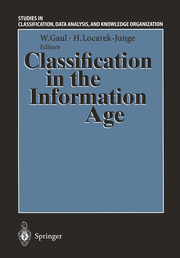-
Zusatztext
-
nd Selected papers presented at the 22 Annual Conference of the German Classification Society GfKI (Gesellschaft fUr Klassifikation), held at the Uni versity of Dresden in 1998, are contained in this volume of "Studies in Clas sification, Data Analysis, and Knowledge Organization". One aim of GfKI was to provide a platform for a discussion of results con cerning a challenge of growing importance that could be labeled as "Classi fication in the Information Age" and to support interdisciplinary activities from research and applications that incorporate directions of this kind. As could be expected, the largest share of papers is closely related to classi fication and-in the broadest sense-data analysis and statistics. Additionally, besides contributions dealing with questions arising from the usage of new media and the internet, applications in, e.g., (in alphabetical order) archeolo gy, bioinformatics, economics, environment, and health have been reported. As always, an unambiguous assignment of results to single topics is some times difficult, thus, from more than 130 presentations offered within the scientific program 65 papers are grouped into the following chapters and subchapters: - Plenary and Semi Plenary Presentations - Classification and Information - Finance and Risk - Classification and Related Aspects of Data Analysis and Learning - Classification, Data Analysis, and Statistics - Conceptual Analysis and Learning - Usage of New Media and the Internet - Information Systems, Multimedia, and WWW - Navigation and Classification on the Internet and Virtual Univ- sities - Applications in Economics
-
-
Autorenportrait
- InhaltsangabePlenary and Semi Plenary Presentations: Classification and Information: M. Grötschel, J. Lügger: Scientific Information Systems and Metadata.- J. Kittler: Multiple Expert Fusion.- T. Ottmann, M. Will: How to Make a Multimedia Textbook and How to Use It.- H.-H. Bock: Clustering and Neural Network Approaches.- O. Gascuel: Data Model and Classification by Trees.- A. Pombortsis, S. Demetriadis, A. Karoulis: A Framework for the Design, Development and Evaluation of Multimedia Based Learning Environments: "ISTOS: An Application in the Computer Networking Domain".- E. Trauwaert: Natural and Constrained Classification of Data by Fuzzy Clustering Techniques.- Finance and Risk: H. Brachinger: From Variance to Value at Risk: A Unified Perspective on Standardized Risk Measures.- G. Bamberg, D. Dorfleitner, R. Lasch: Does the Planning Horizon Affect the Portfolio Structure?.- K. Jajuga: Statistical Approach in Financial Risk Analysis and Management - Review of Concepts.- Classification and Related Aspects of Data Analysis and Learning: Classification, Data Analysis, and Statistics: T. Augustin: On Data-Based Checking of Hypothesis in the Presence of Uncertain Knowledge.- T. Bregenzer: Multivariate Directional Tests with Incomplete Data.- W. Gaul, F. Säuberlich: Classification and Positioning of Data Mining Tools.- O. Gefeller: Hazard Rate Estimation from Censored Data.- J. Grim: A Sequential Modification of EM Algorithm.- U. Halekoh, K. Schweizer: Analysis of the Stability of Clusters of Variables via Bootstrap.- C. Hennig: Models and Methods for Clusterwise Linear Regression.- Yu. Kharin: Statistical Clustering Under Distortions: Optimality and Robustness.- J. Krauth: Discrete Scan Statistics for Detecting Change-points in Binominal Sequences.- J. Mattes, J. Demongeot: Dynamic Confinement, Classification, and Imaging.- K. Pärna, J. Lember, A. Viiart: Approximation of Distributions by Sets.- C. Pesch: Computation of the Minimum Covariance Determinant Estimator.- M. Riani, A. Cerioli: Graphical Tools for the Detection of Multiple Outliers in Spatial Statistics Models.- W.-D. Richter: Classification for Repeated Measurements in Gaussian and Related Populations.- M. Röhl, C. Weihs: Optimal vs. Classical Linear Dimension Reduction.- M. Wagner, S. Michalek, J. Timmer: Testing for the Number of States in Hidden Markov Models with Application to Ion Channel Data.- D. Wishart: ClustanGraphics3: Interactive Graphics for Cluster Analysis.- Conceptual Analysis and Learning: P. Bittner, C. Eckes, K. Wolff: Conceptional Meaning of Clusters.- A. Großkopf: Group Theoretical Structures for Representing Data Contexts.- B. Harris, E. Godehardt: The Comparative Efficacy of Some Combinatorial Tests for Detection of Clusters and Mixtures of Probability Distributions.- M. Herrmann, R. Der: Efficient State-Space Representation by Neural Maps for Reinforcement Learning.- J. Jaworski, Z. Palka: Match-Graphs of Random Digraphs.- M. Lendl, R. Unbehauen: An Improved Training Method for Feed-Forward Neural Networks.- T. Rönsch, G. Weißhahn: Decision Support By Order Diagrams.- I. Vajda: Neural Network Classification in Exponential Models with Unknown Statistics.- R. Wille: Conceptional Landscapes of Knowledge: A Pragmatic Paradigm for Knowledge Processing.- Usage of New Media and the Internet: Information Systems, Multimedia, and WWW: S. Kuhlins, M. Schader: Remote Data Analysis Using Java.- K. Lenz, A. Oberweis, A. v. Poblotzki: Metrics for World Wide Web Information Systems.- R. Schätzle, W. Stucky: Modeling Concepts for Flexible Workflow Support.-
Detailansicht
Classification in the Information Age
Proceedings of the 22nd Annual GfKl Conference, Dresden, March 4-6,1998, Studies in Classification, Data Analysis, and Knowledge Organization
ISBN/EAN: 9783540658559
Umbreit-Nr.: 4151908
Sprache:
Englisch
Umfang: xii, 608 S., 46 s/w Illustr., 608 p. 46 illus.
Format in cm:
Einband:
kartoniertes Buch
Erschienen am 16.07.1999
Auflage: 1/1999


